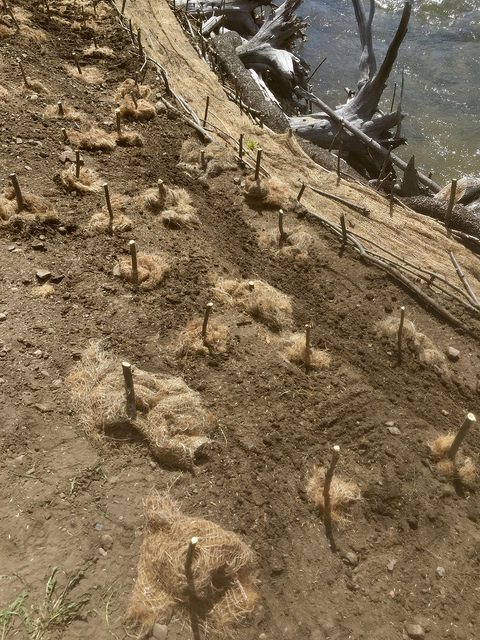*Editor's Note: Last week our dynamic duo, Outreach Assistants Dylan and Dorothy, got some hands-on experience helping the Government of Alberta with some bioengineering and restoration along Lost Creek. They can't wait to tell you all about what they learned!*
What could be better than stakes by the creekside?! The Lost Creek stream banks had been severely impacted by the 2013 flood. Where there used to be one 50 ft channel of water, there are now three channels spanning nearly 110 ft. This site was one of the many areas being restored as part of the Alberta Government's Backcountry Trail Flood Rehabilitation Program, which was enacted after the 2013 floods to repair the trails, replace bridges, and stabilize stream banks across Alberta’s mountain headwaters. The flood created many exposed faces along the bank, which became a source for sedimentation - and because this was happening high in the headwaters, it meant that it was impacting water quality for everyone downstream. As well, the nearby snowmobile hut was in danger of being lost if the creek continued eroding toward it without any mitigation.
Willow Stakes Hold Their Ground
In order to restore continually eroding stream banks, we planted willow stakes to reinforce the ground and decrease sedimentation. An ideal stake is an inch in diameter, at least a metre long, and straight. Willows are amazing plants that can grow from just a section of the trunk placed deep into the ground. In their new location the willow stakes will grow deep roots that hold the soil together and keep it from washing into the creek.
To place the willow stakes, we first dug a hole approximately one meter deep before planting each stake. A deep hole is important because the more the willow is in contact with soil, the more surface area is available for it to take up water and nutrients, and the better chance the willow has to survive. To help increase this contact even more, we used a deadblow mallet to gently tap the stake into the soil (this is when having a straight stake helps!). Finally, we back-filled the hole with soil and tamped it tight; the willow stake should not be easily pulled from the ground.
Coco Matting Retains Moisture
To help the willows have the best possible chance of survival, we wrapped small portions of coco matting around the base of the willow stakes. When laid out over large sections of bare soil, the coco matting acts as an eco-friendly landscaping cloth to minimize soil erosion, retain soil moisture, and prevent the germination of invasive, noxious plants. This particular coco matting had been used at the site to protect the willows that had been planted the previous December. We reused this old matting by cutting segments out to surround each stake.
Root Wads & Wattle Fence brace the banks
This project is located on the outside of a large sweeping bend; because of this it is common for the bank to become undercut and collapse. To combat this, the Government of Alberta had previously installed large dead tree trunks into the bank with the root balls attached; these structures are called root wads. The root wads were placed facing into the bend of the creek to help brace the soil by slowing down the water, thus reducing erosion and sedimentation. These refuges of slower water also offer an ideal habitat for fish like westslope cutthroat trout. We helped repair the wattle fence behind the root wads; this small woven willow fence creates yet another barrier to help catch the soil and keep it from eroding down the creek.
Seeding Reduces Erosion
In order to get full erosion protection for the soil, we seeded a natural grass mix including the fast-growing wild rye. These seeds will quickly establish fibrous root systems that will hold the soil steady against both wind and water erosion, giving the willows time to grow their longer-reaching roots.
After a healthy dousing of water from our backpack sprayers, we laid down a protective layer of debris (deadfall and willow clippings) to help retain moisture and keep wildlife away from the vulnerable willow saplings, which will soon be sprouting leaves. Fingers crossed!
You can help!
As you can see, it takes a lot of planning and hard work to restore our stream banks. We learned about techniques that increase the chance of success, but restoration still takes a long time - many years, in fact! - to reach completion. So if you come across a restoration site during your travels, please give it a wide berth to allow it time to recover.
If you, too, want to get involved with bioremediation and willow staking then we have the event for you. Keep a close eye on OWC's social media for details of our Backcountry Restoration Event coming up in the fall!








